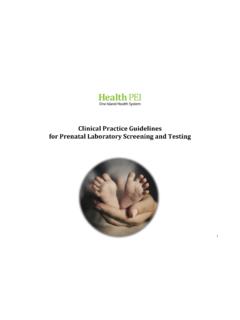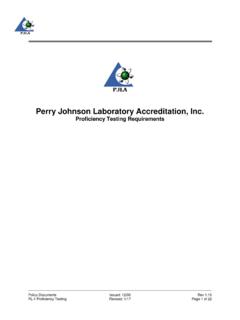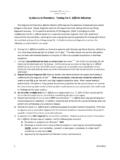Transcription of Laboratory Diagnostic Testing for Borrelia burgdorferi ...
1 4 Laboratory Diagnostic Testing for Borrelia burgdorferi Infection1 Barbara Johnson Introduction Serology is the only standardized type of Laboratory Testing available to support the clinical diagnosis of Lyme borreliosis (Lyme disease) in the USA. It is also the only type of Diagnostic Testing approved by the US Food and Drug Administration (FDA). Of the 77 devices cleared by the FDA for in vitro Diagnostic use for Lyme disease, all are designed to detect immune responses to antigens of Borrelia burgdorferi sensu stricto, particularly IgM and IgG (FDA, 2010).
2 Serological tests do not become positive until an infected individual has had time to develop antibodies. In Lyme disease, this means that early acute disease characterized by an expanding rash (erythema migrans or EM) at the site of a tick bite cannot be reliably diagnosed by serology. After a few weeks of infection, however, immunocompetent people will have made enough antibodies that serology is useful for confirming exposure to B. burgdorferi in all subsequent stages of Lyme disease.
3 Antibody levels remain elevated for months to years aft er the in fection is cured. A variety of direct tests for the agent of Lyme borreliosis have been developed. Direct tests include culture of Borrelia from skin or blood and occasionally cerebrospinal fluid (CSF), and detection of genetic material by PCR in skin, blood, synovial fluid and CSF. These tests have specialized roles in research and in academic and reference laboratories but are not available for routine use.
4 Culture and PCR each have distinct limitations that will be noted in this chapter. Diagnostic tests are of clinical value only if they are used appropriately. This has become particularly important in the fi eld of Diagnostic Testing for Lyme disease, as both patients and doctors hear conflicting information about the risk of Lyme disease in various environments. Furthermore, patients are sometimes given Laboratory Diagnostic tests when they lack objective signs of Lyme disease and a history of potential exposure to infected vector ticks.
5 A healthcare provider must estimate the pre-test likelihood that a patient has Lyme disease in order to under stand the positive and negative predictive values of tests for Lyme disease. Fortunately, there are resources available to assist providers in making this judgement. It is important to know that laboratories may offer in-house Testing for Lyme disease 1 The findings and conclusions in this article are those of the author and do not necessarily represent the views of the Centers for Disease Control and Prevention.
6 CAB International 2011. Lyme Disease: An Evidence-based Approach (ed. Halperin) 73 74 Johnsonthat does not require review and approval by the FDA. Because some in-house tests have not been rigorously developed and validated, the Centers for Disease Control and Prevention (CDC) and FDA recommend that these tests only be used when their accuracy and clinical usefulness have been documented in peer-reviewed scientifi c literature (CDC, 2005).
7 Unvalidated tests as of 2010 include capture assays for antigens in urine, immunofl uorescence staining or cell sorting of cell wall-defi cient or cystic forms of B. burgdorferi , lymphocyte transformation tests, quantitative CD57 lymphocyte assays, reverse Western blots (Feder et al., 2007), in-house criteria for interpretation of im-muno blots and measurements of anti bodies in synovial fl chapter considers the Diagnostic Testing for B.
8 burgdorferi sensu stricto infection, the only organism established to cause Lyme disease in North America. Lyme disease also results from infection by Borrelia garinii or Borrelia afzelii in Europe and Asia, as well as by the recently described Borrelia spielmanii in Europe (Wang et al., 1999; Richter et al., 2006; Fingerle et al., 2008). Borrelia valaisiana and Borrelia lusitaniae have been associated anecdotally with Lyme disease in some parts of Europe (Crowder et al.)
9 , 2010), particularly B. lusitaniae in Portugal (Collares-Pereira et al., 2004). Borrelia bisett ii has been cultured from a few patients in Europe (Strle et al., 1997), but has not been shown to cause human disease in North America. Diagnostic tests for B. burgdorferi sensu stricto will not necessarily perform well for infections by other genospecies of Lyme disease bacteria, although some do ( assays based on the C6 peptide of the variable surface antigen (VlsE) or the whole VlsE protein).
10 Guidelines for Laboratory diagnosis of European Lyme borreliosis are available online in English (Health Protection Agency of the UK, 2010; German Society for Hygiene and Micro-biology, 2000). Two-tiered Serology: the Current Standard for Serodiagnosis in North AmericaThe public health agencies of the USA and Canada advocate a two-step process for measuring antibodies in blood when Lyme disease is suspected. The CDC recommends two-tiered Testing both for the evaluation of individual patients (CDC, 1995) and for epidemiological surveillance for Lyme disease (CDC, 1997).

















